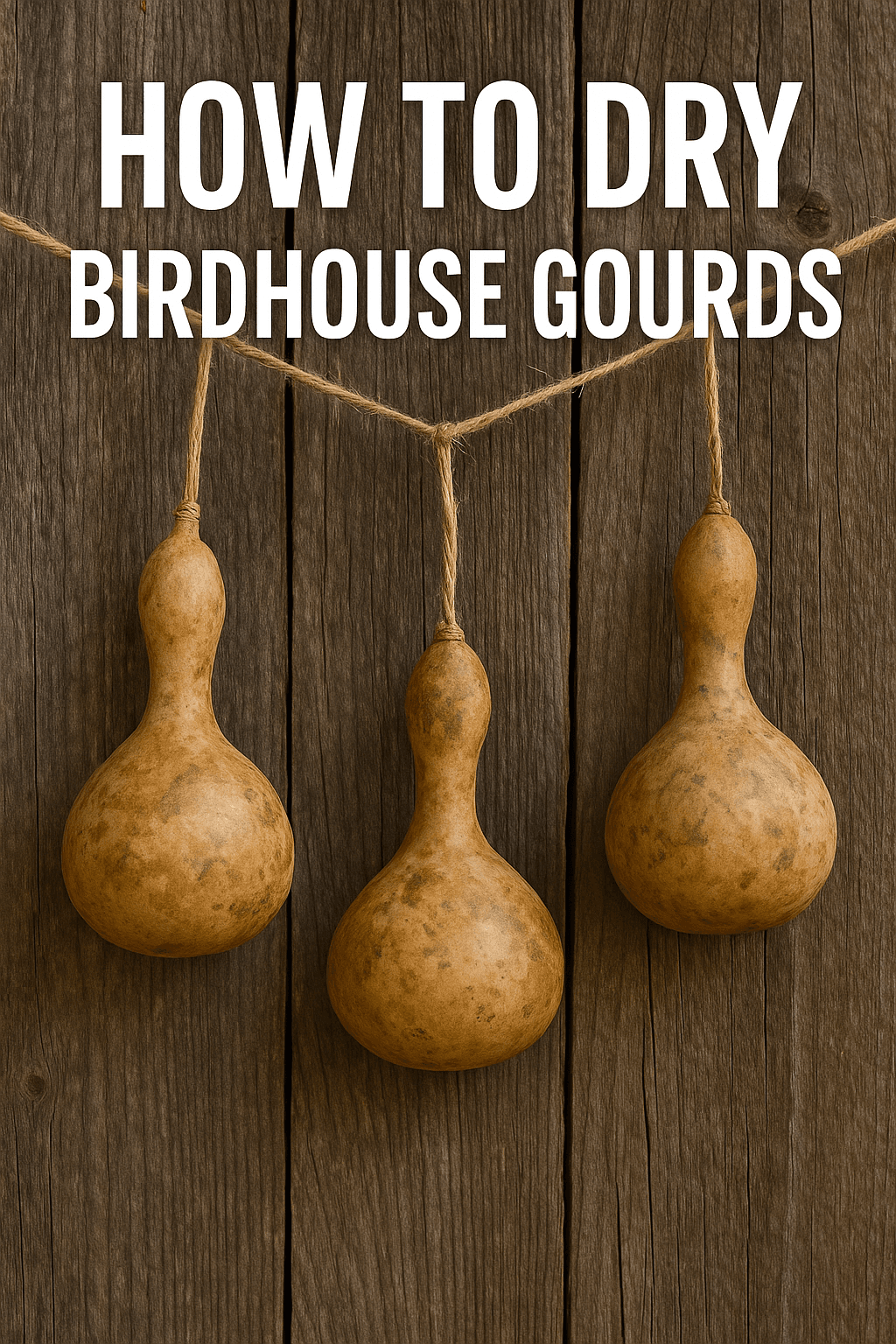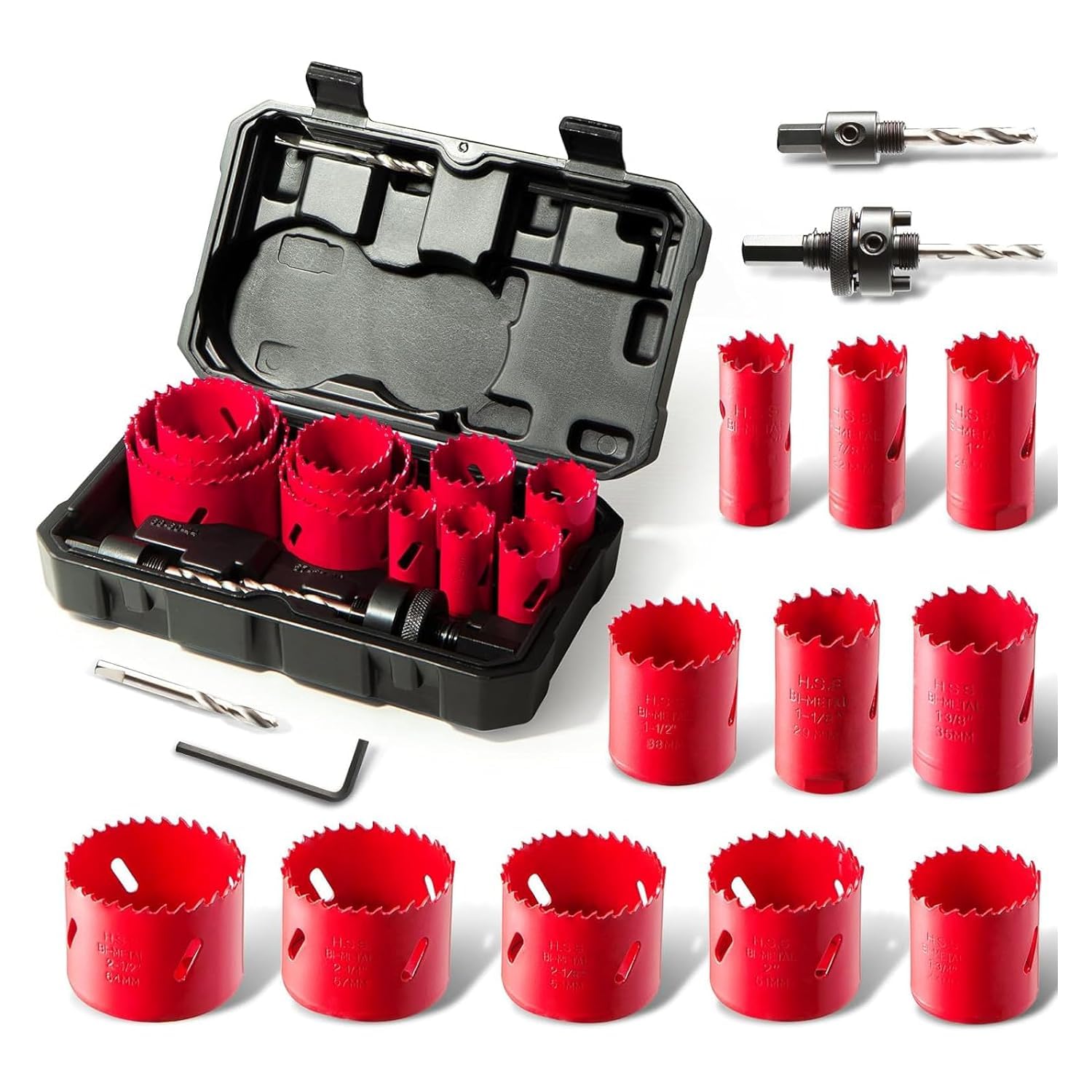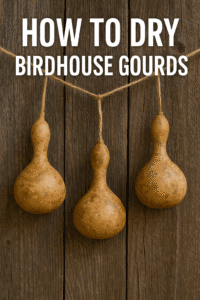How to Dry Birdhouse Gourds: A Complete Guide from Harvest to Hardy Home

There’s a special kind of magic in growing your own birdhouse. It’s a project that connects you to the rhythms of the seasons, from planting a tiny seed in the spring to watching a family of wrens fledge from the finished gourd a year later. But between the vibrant, green gourd on the vine and the hard, hollow, bird-ready home lies the most critical and misunderstood part of the process: curing. Drying a gourd is an exercise in patience, a slow transformation that turns a fleshy fruit into a woody, durable shelter that can last for decades.
My first attempt at drying gourds was a near-disaster. I harvested them too early, stored them in a damp basement, and watched in horror as most of them turned to a mushy, rotten mess. That failure, however, was my greatest teacher. I’ve since successfully cured hundreds of gourds on my Virginia homestead, learning the subtle cues of the plants and the precise conditions needed for success. This guide is everything I learned the hard way, distilled into a step-by-step process. We’ll cover everything from the crucial moment of harvest to the strange (but normal!) process of mold growth, ensuring your gourds transform from garden produce into the perfect natural birdhouse.
The Gourd Drying Process in a Nutshell
For a successful cure, you need to follow these essential stages. It’s a slow process, but the steps are simple.
- Harvest at the Right Time: Wait until the gourd is mature. The stem and tendril next to it should be dry and brown. The gourd should feel firm and its skin should be losing its bright green color. Harvest with 1-2 inches of stem attached, before the first hard frost.
- Initial Cleaning: Wash the gourd with a mild soap or a diluted bleach/vinegar solution to remove dirt and surface bacteria. Dry it thoroughly.
- Find the Perfect Curing Location: Choose a dark, dry, and well-ventilated area like a garage, shed, or covered porch. Good air circulation is the most important factor.
- Set Up for Airflow: Place gourds on a raised platform like a pallet or wire rack, ensuring they don’t touch each other. You can also hang smaller gourds.
- Wait Patiently (3-12 Months): The curing process takes a long time. The outside skin will mottle and mold—this is normal. The gourd will slowly lose water and become lighter.
- Check for “Doneness”: A fully cured gourd will be lightweight, the skin will be hard and brown, and when you shake it, you’ll hear the dried seeds rattling inside.
Why Gourds? The Perfect Home, Crafted by Nature
Before we dive into the “how,” let’s touch on the “why.” What makes gourds so special for birds? For thousands of years, humans have used gourds for everything from bowls to instruments, and birds like Purple Martins have been nesting in them for just as long. Our guide to the best birdhouse gourds explores ready-made options, but growing and curing your own is a uniquely rewarding experience. A properly cured gourd is:
- Naturally Insulating: The thick, woody walls keep the nest cooler in the summer and warmer on cool spring nights.
- Breathable: Unlike plastic, the natural material allows for some moisture exchange, reducing condensation.
- Durable: A thick-walled, cured gourd can last for 30 years or more.
- Appealing to Birds: The organic shape and texture are readily accepted by many cavity-nesting birds.
The Step-by-Step Guide to Perfect Gourd Curing
Step 1: The Harvest – Timing is Everything
This is the most common point of failure. Harvesting a gourd before it’s mature is like trying to make bread with un-risen dough; it will never work. An immature gourd is full of sugar and water and will simply rot. You must wait for the plant to send all its energy into the fruit.
Signs a Gourd is Ready for Harvest:
- The Tendril Test: This is the most reliable indicator. Look at the little curly tendril on the vine right next to the gourd’s stem. When that tendril is completely brown and dry, the gourd is mature.
- The Stem is Dry: The stem holding the gourd should be starting to shrivel and dry out. It should be hard, not soft.
- Skin Hardness: Press a fingernail into the gourd’s skin. If it’s easy to pierce, it’s not ready. If it’s tough and resists your nail, it’s mature.
- Color Fades: The deep, vibrant green of a growing gourd will start to look faded or mottled.
Aim to harvest in the fall, just as the plant’s leaves are beginning to die back but before your first hard frost. A light frost is okay, but a hard freeze can damage the gourd and cause it to rot. When you harvest, use sharp pruners and leave about two inches of stem attached. Never carry the gourd by its stem!
Step 2: The Prep – A Clean Start
Once harvested, your first job is to clean the gourds. The skin is covered in dirt and invisible microbes that can accelerate rot if left unchecked. You have a few options for washing:
- Soap and Water: A simple wash with dish soap and warm water using a soft brush or cloth is often sufficient.
- Diluted Bleach Solution: For a more thorough disinfecting, a solution of 1 part bleach to 10 parts water works well.
- Vinegar Solution: If you prefer to avoid bleach, a 50/50 white vinegar and water solution is a great natural alternative.
After washing, the most important part is to **dry the gourds completely**. Let them sit in the sun for a few hours or wipe them down meticulously with a towel. Placing a wet gourd in a dark curing spot is an invitation for bad mold.
Step 3: The Curing Chamber – Setting the Stage
The ideal curing location has three key features: it must be dark, dry, and, most importantly, have excellent air circulation. A stuffy, damp room will cause rot. Great options include:
- A garage or shed (with a window cracked for airflow)
- A well-ventilated attic
- A covered porch or carport (out of direct rain)
- A basement, but ONLY if it is very dry and you run a fan or dehumidifier.
You need to get the gourds up off the floor where moisture can sit. Laying them on a concrete floor is a guaranteed way to get a rotten spot. Use old wooden pallets, wire shelving, or screens to allow air to circulate underneath them. Make sure the gourds are not touching each other. For smaller gourds, you can even hang them by running a wire through their stems.
Step 4: The Long Wait – What to Expect During Curing
This is where your patience is tested. The process can take anywhere from three months for a small gourd to a full year for a giant one. During this time, the gourd will go through a strange and wonderful transformation.
The Mold Phase (This is Normal!)
My first time curing, I walked into my garage after a month and saw my beautiful gourds covered in ugly, blotchy mold. I thought I had failed again. But this is the most important lesson: **Mold is part of the process.** The mold that forms on the outside is feeding on the moisture in the waxy outer skin (the cuticle). It’s a sign that the gourd is breathing and releasing its water content. It rarely harms the hard shell underneath. The skin will develop a mottled, marbled pattern, which can actually be quite beautiful. You can occasionally wipe off excessive, fuzzy mold with a dry cloth or a cloth dipped in vinegar, but it’s often best to just let it be.
Other Signs of Curing:
- Weight Loss: The gourd will become significantly lighter as the water inside evaporates.
- Skin Hardening: The skin will become progressively harder and more wood-like.
- Color Change: The gourd will turn from green to shades of tan and brown.
- The Rattle: After several months, if you pick up the gourd and shake it, you’ll begin to hear the seeds breaking loose and rattling inside. This is the best sign that the curing process is nearing completion.
Check on your gourds every week or so. Turn them to prevent flat spots and check for any that are becoming soft or mushy. If a gourd starts to rot (gets soft, smells foul), remove it immediately to prevent it from affecting the others.
Essential Tools for the Gourd Artist
While the process is natural, a few key tools can make it easier and more successful. Here are my tried-and-true recommendations.

1. Heavy-Duty Work Gloves
From handling prickly vines at harvest to scrubbing moldy gourds and drilling hard shells, a good pair of gloves is essential. These leather gloves from OZERO are tough enough to protect your hands from scratches and scrapes but offer enough dexterity for detailed work. They are an indispensable tool throughout the entire process.
Check Price on Amazon
2. A Reliable Dehumidifier
If you live in a humid climate, a dehumidifier can be the difference between success and failure. It helps control the moisture in your curing space, creating the ideal dry environment that gourds need to cure properly instead of rotting. This Govee model is perfect for a garage or basement, pulling a significant amount of water from the air and preventing the “bad” kind of mold from taking over.
Check Price on Amazon
3. A Quality Hole Saw Kit
Once your gourd is cured, you need to turn it into a birdhouse. A hole saw kit is the best tool for drilling a perfect, clean entrance hole. This DEWALT kit is a fantastic investment. The different sizes allow you to create the right size entrance for specific birds, from wrens (1-1/8″) to bluebirds (1-1/2″). Remember to research what birds you want to attract to choose the right size. For added security, you can pair this with one of the best birdhouse entry protectors.
Check Price on AmazonThe Final Transformation: From Cured Gourd to Birdhouse
After months of waiting, the day finally comes when your gourds are ready. They will be feather-light, rock-hard, and will rattle when you shake them. Now, the fun part begins!
- Final Cleaning: Submerge the gourd in warm water for about 15-30 minutes. This will soften the moldy outer skin. Then, use a copper or steel scouring pad to scrub the skin off. It’s a messy job, but you’ll be left with a smooth, beautiful tan shell.
- Drill the Entrance: Using your hole saw, drill the entrance hole. The placement should be about two-thirds of the way up the side of the gourd’s main cavity.
- Clean the Inside: Once the hole is drilled, use a long-handled spoon or a bent piece of wire to scrape and pull out the dried seeds and pith from the inside. Save the seeds for next year’s crop!
- Add Drainage & Ventilation: Drill three or four small (1/4-inch) holes in the very bottom of the gourd for drainage. Drill a few more near the top, under the “cap,” for ventilation and to allow you to thread a wire for hanging.
- Preserve (Optional): While a raw gourd will last for years, you can extend its life by painting it with a light-colored exterior latex paint or sealing it with a marine varnish. This is purely optional.
Once complete, you’re ready to hang it! Be sure to follow the best practices in our guide on how to get birds to nest in your birdhouse to give your new, all-natural home the best chance of attracting a family.
Frequently Asked Questions (FAQ)
My gourd has a soft spot. Is it ruined?
Unfortunately, yes. If any part of the gourd becomes soft, squishy, or starts to leak, that means rot has set in. It will not cure properly and should be composted immediately to prevent it from spreading mold spores to your other gourds.
Can I dry gourds in my house?
It’s generally not recommended. The curing process, especially the mold phase, can release a lot of spores and a musty smell into the air, which isn’t ideal for indoor air quality. A garage, shed, or covered outdoor space is much better.
How long does a cured gourd birdhouse last?
An un-treated, thick-walled gourd birdhouse can easily last 10-20 years. If you preserve the outside with paint or varnish, it can last for 30 years or even longer, making it one of the most durable birdhouse options available.
Why do my gourds keep rotting instead of drying?
There are two likely culprits. First, you may be harvesting them too early, before they are fully mature. Refer to the “tendril test” for perfect timing. Second, your curing location is likely too damp or has poor air circulation. Try adding a fan or a dehumidifier to your space.
Conclusion: A Legacy in Your Garden
Drying birdhouse gourds is a journey that teaches patience and observation. It’s a slow, natural process that can’t be rushed, but the reward is a beautiful, durable, and deeply personal home that you created from a single seed. You’ve provided a safe cavity for a new generation of birds, a contribution to your local ecosystem that will last for many seasons to come. It’s a project that connects you to the earth and the creatures we share it with in the most tangible way possible.

